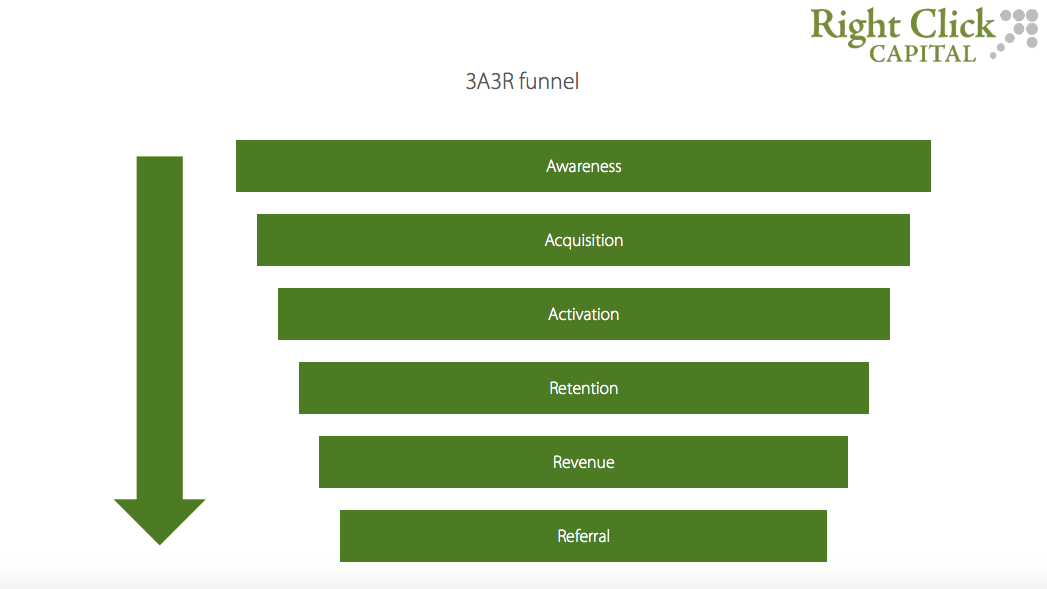This is the second part in a three-part series on startup growth by venture capital investor Benjamin Chong. Part 1 is here & part 3 will be published next week.
Growth marketing has forever changed the way that successful startups approach marketing.
It was reportedly made famous by Facebook, who were one of the first to have a team focused specifically on growth, rather than traditional marketing. And it appears this worked, with Facebook reaching the lofty milestone of two billion monthly active users in just 13 years.
Most founders will be familiar with pirate metrics as coined by Dave McClure in 2007, otherwise known as the AARRR funnel.
These are the five stages of the customer journey; Acquisition, Activation, Retention, Revenue and Referral. Some may not realise that another A, Awareness, has been added to the top of the funnel in recent years, making this the 3A3R funnel.

Figure 1: 3A3R funnel, supplied by Right Click Capital
A holistic approach to the customer
Where old school marketing activity focuses on the top of the sales funnel, channelling customers through the awareness and acquisition stages before handing them to a new team to activate and retain, growth marketing is a holistic approach across the lifecycle of the customer.
As growth guru Andy Johns of US firm Unusual Ventures puts it, “finance owns the flow of cash in and out of a company. Growth owns the flow of customers in and out of a product.”

Right Click Capital’s Ben Chong
In a growth marketing team, different functions from around the business gather customer insights to create a growth marketing program to deepen the customer relationship.
Data scientists, product managers, designers, engineering or developers, and marketing teams work together to achieve a common goal of improving the growth rate by preventing the loss of potential customers at each of the six stages of the funnel. Growth is the magic that happens at the intersection of these teams.
At a recent Founder Institute event Anna Cheng, growth marketing manager at new payments provider, Brighte and formerly at Spaceship, likened the growth marketing approach to patching up a leaking vessel. She said it doesn’t matter how many leads are being poured into the vessel if customers are leaking out further down the vessel.
Growth marketing, according to Anna, is about finding and understanding the holes and fixing these up. It is also about looking at the changes in the rate of growth daily, weekly or monthly, and the influence of factors such as seasonality on a startup’s ability to attract and retain customers at different times.
A data-driven approach
A growth team’s KPIs are tied to overall growth rates. Acquisition metrics such as leads, new users and downloads are one of many inputs into the growth rate which also includes measures for retention, revenue and referral. The goal is to understand how the stages of the funnel interact and track the customer journeys so a startup can see where the customer fall off is occurring and address this through targeted activity.
The growth marketer is the master of experimentation and testing, using data to tweak their approach to engaging and retaining customers. Unlike traditional marketing approaches, the growth marketing team have some authority over product development and are able to suggest product changes that may improve rates of acquisition and retention.
Indeed a lot of other tactics do not fit with the view of traditional marketing activity as they include pricing, sales and web design as well more traditional A/B testing, data-driven email marketing campaigns, referral marketing and building social media communities.
For the bottom part of the funnel there is often a greater emphasis on engineering, design and data. In organisations that have engineering removed from marketing, there can be a noticeable impact on growth as products are not developed in tandem with feedback from customers.
Growth in the early days
Kickstarting growth requires a founder to identify and build core product value based on product market fit. The process of customer development involving extensive iteration and finetuning is necessary to ensure that there is demand for the product and the leads can be converted.
The job of the growth marketing team is to get users to experience or ‘activate’ and use that core value as quickly as possible, and get them to use the product as often as possible within a short period of time in order to retain them.
In the early days of Twitter, a new product manager was tasked with tackling stagnating growth. The Twitter growth team tried a new growth experiment or tested a new hypothesis every day, picking an area in which to engage more users, creating an experiment, and then sat back to watch the impact on growth.
One such experiment was to coax users into following more people during the onboarding process. With the help of engineering and design, a growth marketing tactic started suggesting 10 new accounts to new users shortly after signup. Because these users never had an empty Twitter feed, they were able to experience the product’s value much faster.
A growth marketing approach is a collective mindset where the sum of the parts is greater than the whole. But growth marketing is not a silver bullet and won’t necessarily give a startup overnight success. It requires persistence to test hypotheses, experimentation and the opportunity to carve out specific growth opportunities.
Above all it’s about listening and gathering feedback and acting on these insights. A growth marketing team listens to their customers and builds loyalty and trust by letting the customer know they have been heard and are valued.
This is the second part in a three-part series on startup growth.
NOW READ: Startups as a key to economic recovery part 1: focus on sustainable growth
- Benjamin Chong is a partner at venture capital firm Right Click Capital, investors in high- growth technology businesses.




















Trending
Daily startup news and insights, delivered to your inbox.